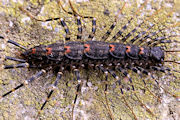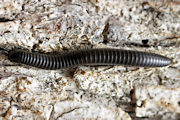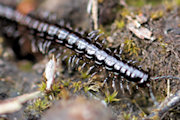
Bushpea Australian Myriapods3 species
Myriapod Group List
Bushpea Myriapods
(The many-legged things you find when not looking for anything)
The Bushpea Gallery currently holds 5 photos of 3 Australian myriapod species.
All insects belong to the subphylum Hexapoda, having in their adult stage six legs, so centipedes and millipedes, which each have more legs than a soccer team, and in many cases several soccer teams, are clearly not insects.
The chief difference between centipedes and millipedes is that centipedes have one pair of legs per body segment while millipedes have two pairs.*
The subplylum Myriapoda, meaning many legs, was created to hold these leggy little creatures instead.
Myriapods are very proficient at using their legs and house centipedes use them not only to move about very quickly but also to hold their prey while they inject it with venom before eating it.
Generally, Myriapods are probably useful to have around as they may clean up pest insects. On the other hand, centipedes and milipedes are amongst the creatures I'm thinking about when I bang my boots together upside-down before putting them on. I only want one leg in each boot and I want it to be mine.
*Imes, Rick (1992). The Practical Entomologist. Simon and Schuster, p.11.



